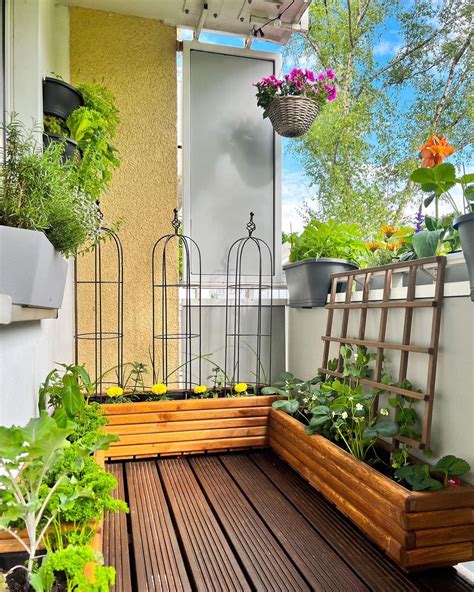How a Balcony Garden Can Improve Your Life: Key Benefits and Practical Advice
In urban settings, access to green spaces is often limited. However, balcony gardening offers a unique opportunity to bring nature into your home. This article explores the numerous benefits of balcony gardening, ranging from mental health improvements to environmental sustainability. Whether you’re a beginner or an experienced gardener, this guide will provide you with practical tips on how to maximize the potential of your balcony garden. We also discuss the design tips and strategies for choosing the best balcony plants to create a peaceful, productive outdoor living space.
Key Concepts
- Balcony gardening: A form of urban gardening where plants are grown in containers on balconies, making it accessible to city dwellers.
- Container gardening: The practice of growing plants in pots, which is ideal for balconies with limited space.
- Outdoor living space: Balconies serve as an extension of the indoor living area, offering space for relaxation and gardening.
Historical Context
Balcony gardening is not a new concept. Historically, small-scale gardening on balconies has been popular in densely populated cities like Paris and Rome, where space is at a premium. In the 20th century, as urban areas expanded, people increasingly turned to container gardening to bring nature into their confined living quarters. Today, with a growing emphasis on sustainability and mental health, urban gardening has seen a resurgence.
Current State Analysis
As urbanization continues, balcony gardens are becoming more than just decorative spaces. Studies show that urban residents who engage in gardening report significant improvements in mental health and overall well-being. Sustainability is also a major factor. Balcony gardens can contribute to reducing carbon footprints by promoting the growth of local plants and reducing the need for imported produce. Furthermore, cities with more greenery are generally cooler, making balcony gardens a small but meaningful contribution to reducing the urban heat island effect.
Practical Applications of Balcony Gardening
Creating a successful balcony garden requires some planning, especially in terms of space and plant selection. Here are a few practical tips:
- Choose the right containers: Opt for lightweight pots that won’t strain your balcony. Ensure they have drainage holes to prevent root rot.
- Select appropriate plants: Depending on your location and the amount of sunlight your balcony receives, choose plants that thrive in those conditions. For example, succulents are ideal for sunny spaces, while ferns do well in shaded areas.
- Soil and watering: Use high-quality potting soil and avoid over-watering. Most balcony plants require well-draining soil and moderate water.
- Maximize vertical space: Install shelves, wall-mounted planters, or trellises to grow more plants without overcrowding your balcony.
Case Studies
| Case Study | Location | Key Insights |
|---|---|---|
| Small Balcony in New York City | NYC, USA | With limited space, the owner used vertical gardening and dwarf fruit trees to maximize output. |
| Sun-Drenched Balcony in Southern California | LA, USA | Succulents and drought-resistant plants were used to create a low-maintenance, sustainable space. |
| Shade Garden in London | London, UK | Herbs and shade-loving plants such as ferns were planted to take advantage of limited sunlight. |
Stakeholder Analysis
Balcony gardening benefits various groups:
- Urban residents: Gain access to green spaces and enjoy the therapeutic effects of gardening.
- Local governments: Promote sustainable living and improve city aesthetics.
- Environmental groups: Support initiatives for urban greening and biodiversity.
Implementation Guidelines
- Assess balcony conditions: Consider sunlight, wind exposure, and weight limitations.
- Plan for maintenance: Choose plants that match your ability to care for them, and set up an easy watering system.
- Think about sustainability: Opt for native plants that support local ecosystems and require less water.
- Incorporate seating: Include a chair or small table to make your balcony a relaxation space as well as a garden.
Ethical Considerations
While balcony gardening is generally a positive activity, there are a few ethical considerations to keep in mind. Ensure that any water runoff from your plants doesn’t negatively impact neighbors below. Additionally, choose sustainable gardening practices by avoiding chemical pesticides and opting for organic methods. Finally, consider using recycled containers or materials for your pots to minimize environmental impact.
Limitations and Future Research
Despite the many benefits of balcony gardening, there are limitations. Space is a significant constraint, and not all plants will thrive in containers or on balconies with poor sunlight. Future research could focus on developing innovative container designs that maximize space and on exploring new plant varieties that are better suited for urban environments. Additionally, more studies on the long-term effects of balcony gardening on mental health could provide valuable insights.
Expert Commentary
Balcony gardening has transformed the way urban residents connect with nature. Experts in both mental health and sustainability agree that this practice offers a range of benefits. “The simple act of tending to plants can reduce stress and improve mood,” says Dr. Laura Simmons, a mental health expert. Additionally, according to horticulturist James Green, “Balcony gardens not only enhance the aesthetic of city living but also contribute to urban biodiversity and environmental sustainability.” With the right planning and plant selection, anyone can create a thriving green space, regardless of how much—or how little—space they have.
Designing a Balcony Garden for Enhanced Privacy and Tranquility
Creating a private, serene outdoor space on your balcony can transform even the smallest urban environments into a personal oasis. Whether you’re seeking solitude or a retreat from neighbors’ prying eyes, planning your balcony garden with privacy in mind is crucial. In this guide, we’ll walk through key concepts, plant choices, practical design strategies, and considerations to help you achieve a lush and private space.
Introduction
Balcony gardens offer the perfect solution for those looking to combine their love for plants with the need for a secluded space. However, urban environments often come with challenges such as limited space, exposure to neighbors, and variations in sunlight. By selecting the right plants, containers, and layout, you can create a shielded sanctuary that suits your needs and maximizes privacy. This article explores essential tips and strategies for designing a balcony garden that offers both beauty and seclusion.
Key Concepts
- Privacy: Achieving a sense of privacy with plants, screens, and strategic layouts.
- Design: How to plan the overall layout of your garden to meet both aesthetic and functional goals.
- Plant Selection: Choosing species that provide coverage, shade, and beauty.
- Containers: Selecting the right pots and containers for optimal plant growth and privacy control.
- Sunlight: Understanding your balcony’s sunlight exposure and how to adapt your plant choices accordingly.
- Growth Potential: Recognizing the growth habits of plants to ensure they offer long-term privacy.
Historical Context
The concept of using plants for privacy is not new. Ancient civilizations, including the Romans, often incorporated greenery into their living spaces to enhance seclusion and serenity. Courtyards filled with trees and shrubbery served both aesthetic and practical purposes. Similarly, balcony gardens have long been a solution for city dwellers seeking to shield their spaces from the urban bustle. Over time, urban gardening techniques have evolved, integrating modern design concepts with traditional gardening practices to balance privacy and beauty in limited spaces.
Current State Analysis
Today, urban gardening has become increasingly popular, driven by rising housing density and a growing interest in eco-friendly living. Balcony gardens are particularly appealing to apartment dwellers who want to enjoy greenery and privacy without access to a traditional backyard. The challenges, however, remain: space is often limited, and the need for privacy is at odds with the exposure of high-rise living. Fortunately, advances in container gardening, plant variety, and vertical gardening techniques have made it easier to design balcony gardens that maximize both space and privacy.
Practical Applications
When planning your balcony garden for privacy, consider the following practical strategies:
- Use Tall Plants and Trees: Bamboo, ornamental grasses, and small trees like dwarf maple can provide excellent natural screening.
- Layering: Combine tall plants with mid-height shrubs and ground cover for a dense, multi-layered effect that blocks unwanted views.
- Vertical Gardens: Install trellises or hanging planters to grow climbing plants like ivy or jasmine, which can create a natural green wall.
- Moveable Screens: For added flexibility, consider using portable plant screens or lattice structures, which can be rearranged as needed.
- Planter Placement: Use tall containers to elevate smaller plants and create more coverage.
Case Studies
To illustrate the effectiveness of these strategies, let’s examine a few real-world examples of successful balcony gardens designed with privacy in mind:
| Case Study | Strategy Used | Result |
|---|---|---|
| Urban Apartment Balcony | Bamboo in tall planters, movable screens | Created a flexible and adjustable privacy shield from neighboring balconies |
| High-Rise Penthouse Garden | Layered planting with tall grasses and climbing plants | Provided natural, aesthetically pleasing privacy while maximizing sunlight exposure |
| Small City Balcony | Vertical garden with trellises and ivy | Saved space while completely blocking the view of adjacent buildings |
Stakeholder Analysis
When designing a balcony garden for privacy, consider the perspectives of multiple stakeholders:
- Residents: The primary beneficiaries of increased privacy and a tranquil outdoor space.
- Neighbors: Some designs may unintentionally block others’ views or sunlight. Be mindful of this when choosing plants and structures.
- Building Management: Certain restrictions may apply to the types of structures and plants you can use. Always check local guidelines.
Implementation Guidelines
- Assess Sunlight Exposure: Before selecting plants, determine the amount of sunlight your balcony receives throughout the day. This will inform your plant choices and layout.
- Select the Right Containers: Opt for containers that are both aesthetically pleasing and functional. Taller pots can elevate plants to provide better screening.
- Maximize Vertical Space: Use trellises, wall-mounted planters, and shelves to expand your growing area and create natural barriers.
- Choose Appropriate Plants: Focus on species that grow tall, dense, and thrive in your specific sunlight conditions.
- Plan for Maintenance: Select plants that fit your gardening skills and maintenance schedule. Low-maintenance options such as succulents or perennial grasses may be ideal for beginners.
Ethical Considerations
In the design of balcony gardens for privacy, ethical considerations should not be overlooked. Here are some key points:
- Environmental Impact: Be mindful of the sustainability of the plants and materials used. Choose eco-friendly containers and organic soil wherever possible.
- Neighbor Relations: Ensure that your privacy-enhancing garden does not block others’ sunlight or views in a way that causes conflict.
- Water Usage: In water-scarce areas, opt for drought-resistant plants to reduce the ecological footprint of your garden.
Limitations and Future Research
While balcony gardens can greatly improve privacy and quality of life, there are inherent limitations. Space constraints may prevent the use of certain large plants, and environmental factors like wind and lack of sunlight can limit growth. Additionally, some urban areas may have restrictions on plant height or the installation of privacy screens. Future research could explore innovative solutions such as lightweight retractable privacy screens or plant species specifically bred for urban balcony environments.
Expert Commentary
As a team of experts in urban gardening, privacy design, and horticulture, we emphasize the importance of planning when creating a balcony garden. Understanding the specific needs of your space and selecting the right plants and structures is key to achieving both beauty and seclusion. Balancing privacy with environmental considerations and neighbor relations ensures that your garden will be a long-lasting and harmonious part of your living space.


